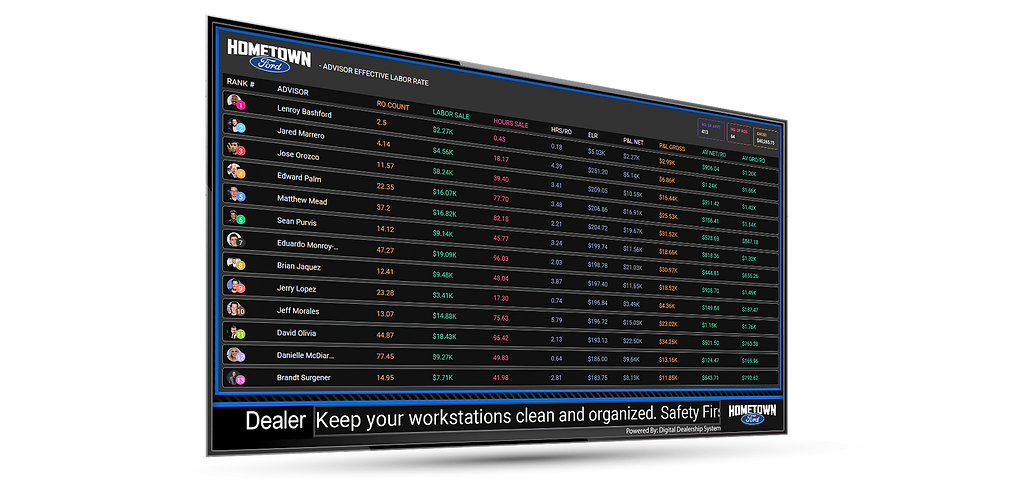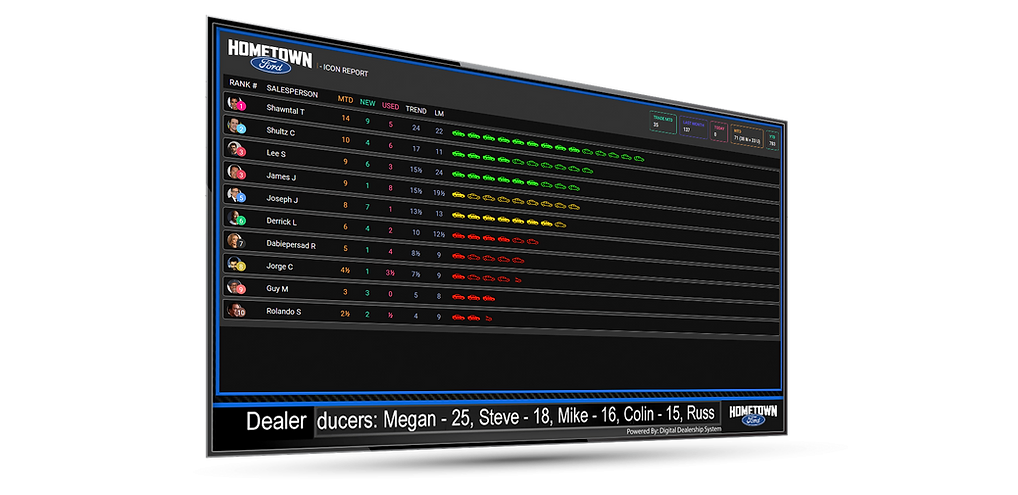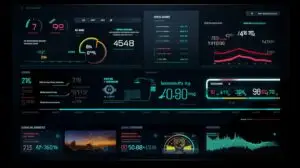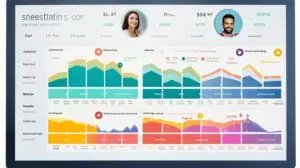As a dealership owner or manager, you already know the importance of dealership KPI tracking, measuring your business performance to identify areas for improvement and maximize profitability.
However, tracking the right key performance indicators (KPIs) is essential to achieving your goals and staying ahead of the competition.
In this article, we will explore the benefits of dealership KPI tracking, guide you through the process of implementing a KPI tracking system, help you choose the most relevant KPIs for your business, and provide tips for maintaining long-term success.
Table of Contents
ToggleKey Takeaways:
- Dealership KPI tracking is essential for maximizing business performance and staying ahead of the competition.
- Implementing a KPI tracking system and choosing the right KPIs are key to achieving your business goals.
- Ongoing monitoring, tracking, and analysis of KPIs are necessary to identify trends and drive performance improvements.
- Using KPI reporting tools and leaderboards can create healthy competition among dealership staff and drive motivation.
- Maintaining an effective KPI tracking system requires consistent effort and attention to detail.
Understanding Key Performance Indicators for Dealerships
Key Performance Indicators (KPIs) are measurable values that indicate how well a dealership is achieving its business goals. KPIs provide valuable insights into various aspects of a dealership’s operations, from sales and service to finance and customer satisfaction.
Common KPI’s for Car Dealership Sales Departments
| Total Units Sold | New Units Sold | Used Units Sold | Pending Deals |
| Front-End Gross | Monthly Trends | 90-Day Average | CSI Ranking |
| Unit Goals | Gross Goals | | |
By tracking these KPIs and others, dealership owners and managers can gain a better understanding of how their business is performing and identify areas where improvements can be made. KPIs can also help to set benchmarks and targets for performance, allowing dealerships to strive for continuous improvement.
“KPIs provide valuable insights into various aspects of a dealership’s operations, from sales and service to finance and customer satisfaction.”

Implementing a KPI Tracking System
Now that you understand the importance of tracking KPIs for your dealership, it’s time to implement a system to do so effectively. The first step is to identify the KPIs that are most relevant to your business goals and objectives. This will help you focus your efforts on the metrics that matter most.
Once you’ve identified your KPIs, it’s time to start tracking them. There are several software solutions available specifically for dealership KPI tracking, and it’s important to choose a solution that is tailored to your needs.
Solutions from Digital Dealership System can help you track your KPIs in real-time, making it easy to identify trends and make informed decisions.

When implementing a KPI tracking system, it’s important to get buy-in from your team. Make sure everyone understands the importance of tracking KPIs and the benefits it can bring to the dealership as a whole.
This includes providing training and support to ensure everyone is on board and knows how to use the software effectively.
Regular monitoring and tracking of KPIs is crucial to the success of your dealership. This will allow you to identify areas where performance is lacking and make adjustments as needed. It’s also important to review and update your KPIs periodically to ensure they remain relevant and aligned with your business goals.
Selecting the Right KPI Tracking Software
Choosing the right KPI tracking software is essential for ensuring the success of your KPI tracking system. Look for solutions that offer customizable dashboards, real-time data updates, DMS-connected, and user-friendly interfaces.
It’s also important to consider the level of support and training provided by the software vendor to ensure your team has the resources they need to succeed.
Check out the offerings from Digital Dealership System for market leading KPI Performance Tracking.
Choosing the Right KPIs for Your Dealership
Choosing the right key performance indicators (KPIs) is crucial for measuring and improving dealership performance. Automotive dealerships have a wide range of KPIs to choose from, and it’s important to select those that align with your business goals and help you make informed decisions to improve profitability and efficiency.
Start by identifying the areas of your dealership that need the most attention. This could be sales, service, parts, or customer satisfaction. Then, select KPIs that are relevant to those areas and can be tracked consistently over time.
Common KPI’s for Car Dealership Fixed Ops Departments
| Effective Labor Rate | Tech Efficiency | Tech Performance | Appointment Goals |
| Appointment Show Rate | Advisor CSI | Gross Goals | Gross per RO |
Remember that not all KPIs will be relevant to every dealership. Consult with your team to determine the KPIs that are most important for your business goals and then closely monitor them to drive performance improvement.

Setting KPI Targets and Benchmarks
Once you have selected the most relevant KPIs for your dealership, the next step is to set achievable targets and benchmarks.
Targets are specific, measurable goals that your dealership aims to achieve within a given timeframe. Setting targets helps you track progress towards your overall business objectives and identify areas for improvement. Targets should be challenging yet attainable, and they should be regularly reviewed and adjusted to reflect changes in your business environment.
Benchmarks, on the other hand, are industry standards or performance metrics that your dealership can use to compare its performance against other similar businesses.
By measuring and comparing your dealership’s KPIs against benchmarks, you can gain insights into your strengths and weaknesses and identify opportunities for improvement. Benchmarks can be used to set realistic goals and drive continuous improvement.
When setting targets and benchmarks, it’s important to involve your team and ensure everyone is on the same page. Use clear, concise language, and make sure your goals align with your overall business strategy.

By setting realistic targets and using relevant benchmarks, you can ensure your dealership is on track to achieve its business objectives and outperform competitors in your industry.
Monitoring and Tracking KPIs
Once you have selected the KPIs that are most relevant to your dealership and set realistic targets, it’s time to monitor and track those metrics regularly. This ongoing process is critical for identifying trends, making informed decisions, and driving performance improvements.
One effective way of tracking KPIs is to use a dashboard that visualizes the data in real-time. A well-designed dashboard can provide a quick overview of how your dealership is performing and highlight any areas that require attention.
There are many dashboard solutions available, ranging from simple spreadsheets to sophisticated DMS-Connected platforms such as those offered by the Digital Dealership System with advanced analytics capabilities.
It’s also important to establish a process for reviewing and analyzing KPI data on a regular basis. This will help you identify patterns, spot anomalies, and make data-driven decisions that can lead to improved performance.
It’s a good idea to set aside dedicated time each week or month to review your KPI metrics, track progress toward targets, and make any necessary adjustments to your strategy.
Real-Life Example: Monthly Service Performance Report
At ABC Motors, the service department uses a monthly performance report to track key metrics and identify areas for improvement.
In addition to these KPIs, the report includes a section for comments and action items, where the service manager can provide more context and outline specific steps to address any issues identified.
This report is reviewed by the entire service team at a monthly meeting, where they discuss the results and collaborate on ways to improve performance in the upcoming month.
By implementing a systematic approach to monitoring and tracking KPIs, ABC Motors has been able to achieve consistent improvements in its service department performance.
Effective Labor Rate Tracking – Digital Dealership System
Using KPI Reporting Tools
Implementing a KPI tracking system without a way to visualize and analyze the data is like driving a car blindfolded. That’s where KPI reporting tools come in.
These tools offer a comprehensive dashboard for tracking dealership metrics, highlighting areas of strength and areas needing improvement. KPI reporting tools allow dealerships to monitor progress and make data-driven decisions to increase performance.
One such tool is the DealerSocket reporting dashboard, which provides a clear overview of dealership performance metrics, including sales, service, and financing. The easy-to-use interface allows managers to easily track progress toward targets and identify areas of concern.
Another option is AutoAlert’s Performance Analytics reporting system, which offers real-time updates on KPIs through an intuitive dashboard. With it, dealerships can track sales performance, inventory turnover, and even individual employee performance.
The Digital Dealership System KPI Performance Tracking Systems pull from the DMS and CRM for reporting on Sales, Finance, Service, Techs and BDC with automated updates as often as every 15 minutes. Reports are displayed on screens in key department locations.
Choosing the right KPI reporting tool for your dealership depends on various factors, including the size of your dealership and your specific goals. It’s important to research and test different options to find the one that best suits your needs.
Sales Leaderboard for Car Dealers – Digital Dealership System
Whatever tool you choose, KPI reporting is an essential component for any dealership to drive performance and achieve success.
Leveraging Leaderboards for Motivation
Creating a culture of healthy competition among employees is an effective way to increase motivation and drive better performance across the dealership. The use of leaderboards is an excellent tool to facilitate this type of friendly competition.
Leaderboards are used to rank employees based on their performance in specific KPIs. For example, a sales leaderboard can rank salespeople based on their monthly sales figures or conversion rates.
A service leaderboard can rank service advisors based on customer satisfaction scores or repair order counts. A technician leaderboard can rank technicians based on the number of hours billed per week.
By displaying the leaderboard in a public area of the dealership, such as a break room or sales floor, employees can see where they stand in relation to their peers. This can be a powerful motivator to work harder and strive for the top spot on the leaderboard.
It’s essential to ensure that the leaderboard is seen as a positive tool for motivation, rather than a source of negativity and discouragement.
Avoid displaying the bottom performers to the entire dealership, as this may lead to resentment and a negative culture. Instead, focus on highlighting the top performers and celebrating their success while providing support and resources for those who may be struggling.
Consider creating different leaderboards for different teams or departments, such as a BDC leaderboard for lead generation and follow-up, or a parts and accessories leaderboard for sales of these items. By tailoring leaderboards to specific job functions, all employees can participate in the friendly competition and have opportunities to shine.
Top Tips: Use leaderboards to create healthy competition among employees and drive motivation for achieving KPI targets. Display the leaderboard in a public area to provide visibility and encourage participation. Avoid negative culture by focusing on top performers and celebrating success while providing support and resources for those who may be struggling. Create different leaderboards for different teams or departments to encourage participation from all employees.
Analyzing Dealership Performance Metrics
One of the most important aspects of dealership KPI tracking is analyzing the performance metrics to gain insights into your dealership’s operation. By examining the data, you can identify trends, strengths, and weaknesses, and make informed decisions to drive improvements.
When analyzing dealership performance metrics, it’s important to focus on the metrics that are most relevant to your dealership’s goals. For example, if your goal is to increase sales, you should closely monitor metrics such as lead conversion rates, closing rates, and average profit per sale.
Another key metric to track is customer satisfaction. Customer feedback is critical in determining the success of your dealership. By analyzing customer satisfaction data, you can identify areas for improvement in customer service and overall customer experience.
It’s also important to keep an eye on your dealership’s finances. Tracking financial metrics such as gross profit margins, expenses, and cash flow can give you a clear understanding of the financial health of your dealership.
Overall, analyzing performance metrics is critical for making data-driven decisions that can drive success in your dealership. By regularly reviewing and examining the data, you can stay on top of trends, identify opportunities for improvement, and make informed decisions to drive your dealership forward.
Creating a KPI Dashboard for Dealers
One of the most effective ways to stay on top of dealership performance is by creating a KPI dashboard. This dashboard provides real-time visibility into the most critical metrics for your dealership and enables quick decision-making by consolidating all key information in one place.
When creating a KPI dashboard, it is important to consider what information is most relevant to your dealership. Start by determining what KPIs you want to track and organize them in a clear and concise manner. This can be done by dividing the dashboard into different sections or by creating separate tabs for different KPI categories.
It is also important to choose the right visualization tools to make the data easily digestible.
Graphs, tables, and charts can all be effective ways to display information, but it is important to choose the right one for each KPI. For example, a stacked bar graph may be more effective for showing year-over-year sales growth, while a table may be more suitable for displaying service department productivity metrics.
Another consideration when creating a KPI dashboard is to ensure that it is easily accessible to all relevant stakeholders and staff. The KPI Dashboard from the Digital Dealership System, for instance, has reports on screens, desktops and mobile devices.
With this tool at your disposal, you can stay on top of performance trends in real-time and make informed decisions to drive success for your dealership.
Tips for Maintaining KPI Tracking Success
Implementing a KPI tracking system is just the first step in optimizing your dealership’s performance. To ensure continued success, it’s important to maintain and regularly review your KPIs. Here are some tips for maintaining KPI tracking success:
- Regularly review and update your KPIs. As your dealership evolves, so should your KPIs. Regularly review and update them to ensure they are still relevant and aligned with your business goals.
- Communicate with your team. Ensure your team understands the importance of KPIs and how they can help achieve dealership success. Keep them informed of any changes or updates to your KPIs and provide ongoing training as needed.
- Regularly monitor and track your KPIs. Set up a regular schedule for monitoring and tracking your KPIs. This will enable you to identify trends and make any necessary adjustments in a timely manner.
- Use KPI data to drive performance improvements. Utilize the insights gained from analyzing KPI data to improve overall dealership performance. Use the data to identify areas for improvement and implement action plans to address them.
- Recognize and reward your team. Publicly recognize and reward team members who consistently achieve or exceed KPI targets. This will help create a culture of healthy competition and motivate your team to strive for success.
By following these tips, you can maintain an effective KPI tracking system that drives dealership success and helps you achieve your business goals.
Conclusion
In conclusion, implementing a dealership KPI tracking system is crucial for maximizing a dealership’s performance in an increasingly competitive automotive industry.
By understanding key performance indicators, choosing the most relevant ones, setting realistic targets and benchmarks, and leveraging reporting tools and leaderboards, dealerships can gain valuable insights into their performance and identify areas for improvement.
Ongoing monitoring and analysis of KPIs, along with the creation of a KPI dashboard, can help dealership owners and managers make informed decisions and drive success.
However, it is not enough to simply implement a KPI tracking system – it must be maintained and adapted to the evolving needs of the dealership. By following best practices and regularly reviewing and revising KPIs, dealerships can ensure that they are effectively tracking performance and achieving their business goals.
FAQ
Q: What is dealership KPI tracking?
A: Dealership KPI tracking is the process of monitoring, measuring, and maintaining key performance indicators (KPIs) in a dealership to maximize its performance and success.
Q: Why is dealership KPI tracking important?
A: Dealership KPI tracking is important because it allows dealership owners and managers to measure their business’s performance, identify areas for improvement, and make informed decisions to drive success.
Q: What are key performance indicators for dealerships?
A: Key performance indicators for dealerships are specific metrics used to measure and evaluate the performance and success of various aspects of a dealership, such as sales, service, customer satisfaction, and profitability.
Q: How do you implement a KPI tracking system in a dealership?
A: Implementing a KPI tracking system in a dealership involves identifying the relevant KPIs for the business, selecting a specialized KPI tracking software, and setting up a system to collect and analyze the necessary data.
Q: How do you choose the right KPIs for your dealership?
A: When choosing the right KPIs for your dealership, it’s important to align them with your business goals and objectives, consider industry benchmarks and best practices, and focus on metrics that directly impact your dealership’s success.
Q: Why is it important to set KPI targets and benchmarks?
A: Setting KPI targets and benchmarks is important because it provides a clear benchmark for measuring performance, helps track progress towards goals, and motivates dealership staff to strive for improvement.
Q: How do you monitor and track KPIs?
A: Monitoring and tracking KPIs involves regularly collecting and analyzing data, using KPI reporting tools, creating dashboards, and reviewing performance trends to identify areas of improvement and make data-driven decisions.
Q: What are KPI reporting tools?
A: KPI reporting tools are software or platforms that help dealership owners and managers collect, analyze, and visualize KPI data, providing insights into performance trends and facilitating informed decision-making.
Q: How can leaderboards be leveraged for motivation in a dealership?
A: Leaderboards can be used in a dealership to create healthy competition among staff by displaying performance rankings, encouraging individuals to strive for higher KPI achievements, and driving motivation to excel.
Q: How can dealership performance metrics be analyzed?
A: Dealership performance metrics can be analyzed by reviewing trends over time, comparing against benchmarks, identifying correlations, and using data visualization techniques to gain insights and make data-driven decisions.
Q: What is a KPI dashboard for dealers?
A: A KPI dashboard for dealers is a visual tool that displays key performance indicators in real-time, providing a comprehensive overview of dealership performance and facilitating quick and easy monitoring and analysis.
Q: How can dealership KPI tracking be maintained for long-term success?
A: Maintaining dealership KPI tracking for long-term success involves regular monitoring, updating targets as needed, providing ongoing training and support to staff, and continually reviewing and improving the tracking system.

Sam Oscar is a freelance technology writer with a passion for cars and a knack for making complex tech accessible. With a background in Computer Science and a lifelong love for automobiles, he specializes in exploring the intersection of emerging technologies and the automotive world. From electric vehicles and AI-driven systems to infotainment and IoT integration, Sam’s writing offers insightful analysis on how innovations are reshaping the way we drive.
His work appears across top tech and automotive platforms, earning him a loyal readership of enthusiasts and industry followers. Active in online communities and a regular presence at major tech and auto events, Sam brings both expertise and enthusiasm to everything he writes.











